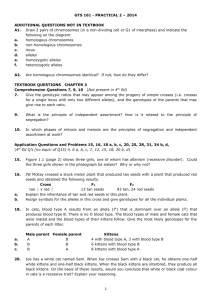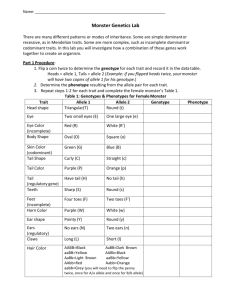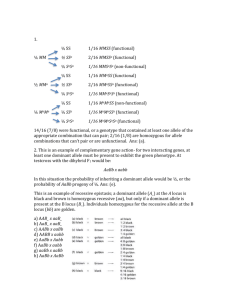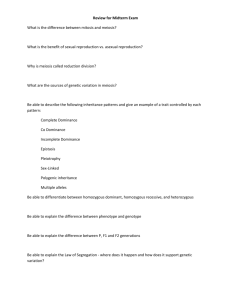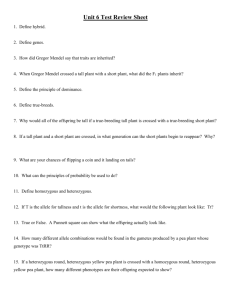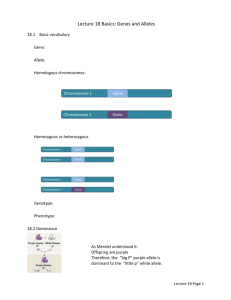GTS 161 Practical 2 Memo 2014
advertisement
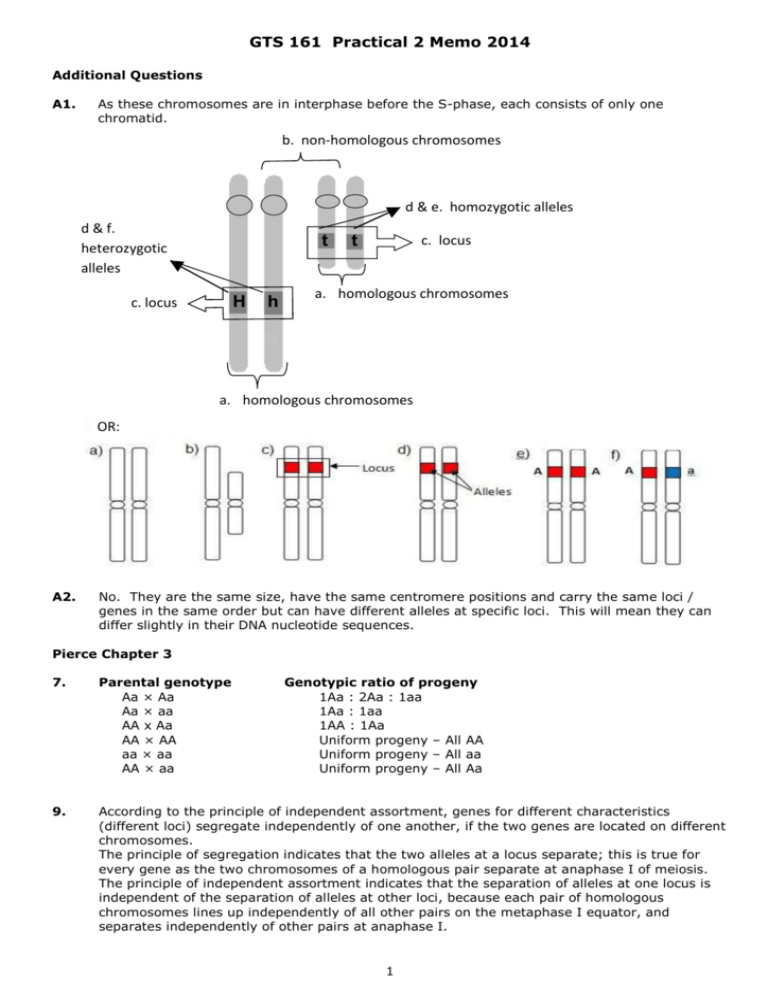
GTS 161 Practical 2 Memo 2014 Additional Questions A1. As these chromosomes are in interphase before the S-phase, each consists of only one chromatid. b. non-homologous chromosomes d & e. homozygotic alleles d & f. heterozygotic alleles t H c. locus h t c. locus a. homologous chromosomes a. homologous chromosomes OR: A2. No. They are the same size, have the same centromere positions and carry the same loci / genes in the same order but can have different alleles at specific loci. This will mean they can differ slightly in their DNA nucleotide sequences. Pierce Chapter 3 7. Parental genotype Aa × Aa Aa × aa AA x Aa AA × AA aa × aa AA × aa Genotypic ratio of progeny 1Aa : 2Aa : 1aa 1Aa : 1aa 1AA : 1Aa Uniform progeny – All AA Uniform progeny – All aa Uniform progeny – All Aa 9. According to the principle of independent assortment, genes for different characteristics (different loci) segregate independently of one another, if the two genes are located on different chromosomes. The principle of segregation indicates that the two alleles at a locus separate; this is true for every gene as the two chromosomes of a homologous pair separate at anaphase I of meiosis. The principle of independent assortment indicates that the separation of alleles at one locus is independent of the separation of alleles at other loci, because each pair of homologous chromosomes lines up independently of all other pairs on the metaphase I equator, and separates independently of other pairs at anaphase I. 1 10. In anaphase I of meiosis, each pair of homologous chromosomes segregate independently of all other pairs of homologous chromosomes. The assortment is dependent on how the homologs line up during metaphase I. This random assortment of homologous pairs explains how genes located on different chromosomes will separate independently of one another. Anaphase II results in the separation of sister chromatids and subsequent production of gametes carrying single alleles for each gene locus as predicted by Mendel’s principle of segregation. Mendel’s principles of independent assortment and segregation do not apply to mitosis, which produces cells genetically identical to each other and to the parent cell. 15. Yes, they could be sisters. Albinism is inherited as an autosomal recessive trait, meaning that a person must receive two copies of the albino allele, one from each parent, implying that both parents had to be heterozygous (carriers of this allele). These parents could therefore have produced normal pigmented children (being homozygous dominant or heterozygous) or albino children (being homozygous recessive). 16. a. The F1 generation contains all tan seed progeny and is the result of crossing a tan seed plant with a red seed plant. The F1 result suggests that the tan phenotype is dominant to red. In the F2 generation, the ratio of tan to red seed plants is about 3.9 to 1, which is similar but not identical to a 3 to 1 F2 ratio expected for monohybrid cross involving dominant and recessive alleles. The F2 ratio therefore suggests that the F1 parents which show the dominant tan phenotype are heterozygous. b. Define the dominant tan allele as “R” and the recessive red allele as “r.” Tan seed ♀ parent: RR Red seed ♂ parent: rr F1 tan seed offspring: Rr F2 tan seed offspring: RR or Rr F2 red seed offspring: rr 18. IA (type A) > iB (type B) IA IA = type A IA iB = type A iB iB = type B a. ♂ type A × ♀ type B → 4 type A and 3 type B kittens Because the female parent has blood type B, she must have the genotype i BiB. The male parent could be either IAIA or IAiB. However, as some of the offspring are kittens type B, the male parent must have contributed an iB allele to these kittens. Therefore, the male must be genotype IAiB. b. ♂ type B × ♀ type B → 6 type B kittens Because type B is caused by the recessive allele iB, both parents must be homozygous for the recessive allele or iBiB. Each contributes only the iB allele to the offspring. c. ♂ type B × ♀ type A → 8 type A kittens The male with type B blood must be iBiB. A female with type A blood could have either the IAIA or IAiB genotypes. Because all of her kittens have type A blood, this suggests that she is likely to be homozygous for the for IA allele (IAIA) and contributes only the IA allele to her offspring. It could be possible that she is heterozygous for type A blood, but if so it is unlikely that chance alone would have produced eight kittens with blood type A. 20. The black coat colour is likely recessive. When Sam was crossed with a black cat, one-half the offspring were white and one-half were black. This 1:1 ratio potentially indicates that one of the parental cats is heterozygous, while the other parental cat is homozygous recessive (typical testcross ratio). The interbreeding of the black kittens produced only black kittens, indicating that the black kittens are likely to be homozygous, and thus the black coat colour is the recessive trait. If the black allele was dominant, we would have expected the black kittens to be heterozygous, containing a black coat colour allele and a white coat colour allele. Under this condition, we would expect one-fourth of the progeny from the interbred black kittens to have white coats. Because this did not happen, we can conclude that the black coat colour is likely recessive. 2 25. a. b. c. d. 28. a. b. c. d. 1/6. P(rolling either a 1 OR a 2) = 1/6 + 1/6 = 2/6 = 1/3 P(rolling either a 2 OR a 4 OR a 6) = 1/6 + 1/6 + 1/6 = 3/6 = ½ P(rolling a 1 OR a 2 OR a 3 OR a 4 OR a 5) = 1/6 + 1/6 + 1/6 + 1/6 + 1/6 = 5/6 OR 1 – P(rolling a 6) = 1 – 1/6 = 5/6 Let P (normal, no PKU) > p (PKU) PP = normal Pp = normal pp = PKU As two normal parents produce a child with the disease, they both have to be carriers (heterozygous), i.e. Pp genotype Pp x Pp → GR: ¼ PP : ½ Pp : ¼ pp PR: ¾ normal : ¼ PKU ½ ½ P(child with PKU) = P(pp offspring) = P(p-allele ♂ and p-allele from ♀) = ½ × ½ = ¼ OR directly from progeny calculated for cross: P(pp offspring) = ¼ P(Pp offspring) = P[(P-allele ♂ and p-allele from ♀) or (p-allele ♂ and P-allele from ♀)] = (½ × ½) + (½ × ½) = ½. OR directly from progeny calculated for cross: : P(Pp offspring) = ½ 31. B (bitter) > b (sweet) BB = bitter Bb = bitter bb = sweet a. P F1 F1 x F1 F2 S (yellow spots) > s (no spots) SS = yellow spots Ss = yellow spots ss = no spots BB SS × bbss GR: All Bb Ss PR: All bitter fruit, yellow spots Bb Ss × Bb Ss. PR: 9/16 bitter fruit, yellow spots 3/16 bitter fruit, no spots 3/16 sweet fruit, yellow spots 1/16 sweet fruit, no spots b. Backcross of F1 plant (Bb Ss) x bitter, yellow-spotted parent (BB SS) ↓ GR: ¼ BBSS : ¼ BBSs : ¼ BbSS : ¼ BbSs PR: all bitter, yellow-spotted offspring. c. Backcross of F1 plant (Bb Ss) x sweet, nonspotted parent (bb ss) ↓ GR: ¼ BbSb : ¼ Bbss : ¼ bbSs : ¼ bbss PR: ¼ bitter fruit, yellow spots : ¼ bitter fruit, no spots : ¼ sweet fruit, yellow spots : ¼ sweet fruit, no spots 34. The easiest procedure for determining the proportion of a particular genotype in the offspring is to break the cross down into simple crosses, and consider the proportion of the offspring for each cross. Aa Bb Cc dd Ee × Aa bb Cc Dd Ee Locus 1: Aa × Aa → ¼ AA : ½ Aa : ¼ aa Locus 2: Bb × bb → ½ Bb : ½ bb Locus 3: Cc × Cc → ¼ CC : ½ Cc : ¼ cc Locus 4: dd × Dd → ½ Dd : ½ dd Locus 5: Ee × Ee → ¼ EE : ½ Ee : ¼ ee b. d. Aa bb Cc dd ee: ½ (Aa) × ½ (bb) × ½ (Cc) × ½ (dd) × ¼ (ee) = 1/64 AA BB CC DD EE: Will not occur. The Aa Bb Cc dd Ee parent cannot contribute a D allele (offspring genotype DD not possible), and the Aa bb Cc Dd Ee parent cannot contribute a B allele (offspring genotype BB not possible). 3 Additional Questions A3. A (absence of moles) > a (moles present) AA = absence of moles Aa = absence of moles aa = presence of moles For this couple: Aa x Aa → GR: 1/4 AA : 1/2 Aa : 1/4 aa (or 1 AA : 2 Aa : 1aa) PR: 3/4 absence of moles : 1/4 presence of moles (or 3 no moles :1 moles) Let p = P(absence of moles) = ¾ q = P(presence of moles) = ¼ a. (p + q)5 = p5 + 5p4q + 10p3q2 + 10p2q3 + 5pq4 + q5 b.(i) P (child with moles) = q = ¼ (ii) P (5 without moles) = p5 = (3/4)5 = 0,237 (iii) P(1st moles and 2nd moles and 3rd no moles and 4th no moles and 5th no moles) = (1/4)2(3/4)3 = 0,026 (iv) P(3 without and 2 with) = 10p3q2 = 10(3/4)3(1/4)2 = 0,264 c. This is an example of conditional probability. As the child in question has no moles (dominant phenotype), his genotype cannot be aa, he must be either AA or Aa. As the parents are both heterozygous, the expected offspring ratio is 1 AA : 2 Aa : 1aa. However if you only consider those offspring with the dominant phenotype, the ratio is 1 AA : 2 Aa. So the probability for the child without moles to be heterozygous (Aa) is ⅔ 4 A4. a. Consider each locus separately, and convert numbers to ratios. Leaves: 122 + 118 = 240 wavy; 38 + 41 = 79 smooth 240 : 79 → approximately 3:1 ratio Typical ratio resulting from cross between 2 individuals both heterozygous for a dominant trait. Let leaf shape be controlled by the A locus, with alleles A and a. A (wavy) > a (smooth) AA = wavy Aa = wavy aa = smooth Genotypes of parents for A-locus: Aa x Aa Pollen: 122 + 28 = 160 round; 118 + 41 = 159 long 160 : 159 → approximately 1:1 ratio Typical ratio where one parent is heterozygous for dominant trait, and the other is homozygous recessive. Let pollen shape be controlled by the B locus, with alleles B and b. B (round) > b (long) OR: B (long) > b (round) BB = round BB = long Bb = round Bb = long bb = long bb = round Genotypes of parents for B-locus: Bb (round) x bb (long) OR Bb (long) and bb (round) (there is not enough information available to enable you to decide which allele is dominant). b. Parents: c. AaBb x Aabb wavy round wavy long OR Aabb x AaBb wavy round wavy long AaBb x Aabb Ab ab AB AABb AaBb Ab AAbb Aabb aB AaBb aaBb Ab Aabb aabb GR: 1 AABb : 2 AaBb : 1 AAbb : 2 Aabb : 1 aaBb : 1 aabb 1 aabb 5 PR: 3 A_B_ 3 wavy round 3 A_bb 3 wavy long 1 aaB_ 1 aabb 1aabb 1 smooth round 1 smooth long 1 smooth long

